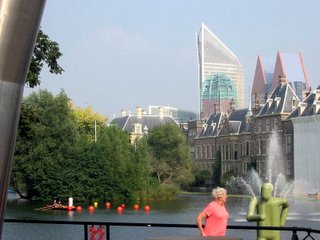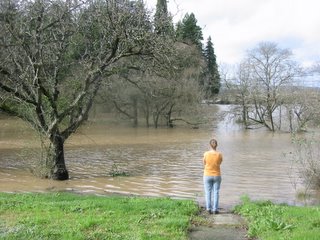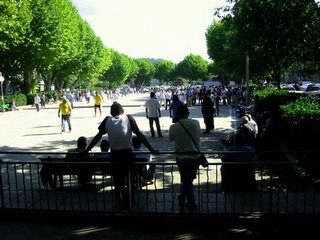Healdsburg, a week laterAND SO WE’RE HOME again, after a final
uitsmijter in an ordinary bar-cafe in the Marriott Hotel, and a trudge back to our hotel the Prinsen, shuffling through new-fallen snow and chuckling at the windshields, on half of which someone had scraped the word BRASIL through the snow, and getting up next morning at six to take the tram and the train to the airport, and then spending six hours at the Atlanta airport because San Francisco was all backed up because of the storm.
And we’ve unpacked, and sat stuck in the house two or three days because the river was up over the road, and six days in the Netherlands seem an awful long time ago, until I look back over my notes, to find:
A'dam details home mentally ill; hotels tech (iens, metro...) Yes, that strange and beautiful building across from our hotel room was a mental hospital. Richard and Marta found that out the day we went to Hans and Anneke’s anniversary party: that night the hospital had a party of its own, with musicians in many of the rooms, and apparently even outside, and everyone staff patients visitors and all seemed to be having a good time; What’s going on, Richard asked someone, Christmas party came the answer, and the other details.
I may not have mentioned (though perhaps I have, in which case forgive me) that the Dutch have four days of Christmas: St. Nicholas’s Day on Dec. 2, I think it is, when gifts are exchanged; Christmas Day on the 25th, when one visits one’s parents; Second Christmas Day on the 26th, when one has a nice quiet day at home; Jan. 6, Epiphany, when one celebrates the end of Christmas. This is all part of that Dutch fondness for
gezelligheid, for comfort and company and snug domesticity -- “values” more bourgeois than Calvinist, perhaps; but values it’s hard to argue with.
* * *
I DIDN’T WRITE MUCH about Hans and Anneke’s celebration, because, well, one doesn’t write publicly about the closely-held narrative of one’s friends. (I already felt I’d overstepped propriety a bit a few pages back, in writing about Kees’s restaurant Marius.) But our friendship with this family has given us some insight into what seems to me a characteristically Netherlandish approach to weddings, anniversaries, birthdays, Christmas: and over and again I come away from these insights, and the experiences suggesting them, with real respect for the “values,” the attitudes and even the institutions, that underlie them.
I am not religious myself, and certainly not monotheistic; but I don’t begrudge others their rituals.
Heer, dank U voor het lekkere eten (Lord, thank you for the delicious eats) doesn’t seem a bad beginning to a comfortable meal, once past the first word. And a longish but not quite too long disquisition on Generosity and Gratitude at an anniversary was certainly something to think about.
The speaker, in fact a minister, suggested that a good marriage is a gift; we ought to be grateful for it, and recognize the generosity of the source of the marriage -- after all, no one forced any power to grant it. But one ought also to recognize that with the gift came a responsibility to make the best of it, to tend it -- even to improve what Nature, as I prefer to think of it, has given. I thought, of course, about our own marriage, and those of a number of close friends and relations; and I looked around at the guests -- over a hundred people, nearly all at least as old as we are (excluding the children and grandchildren of the anniversary couple). A surprising number had celebrated their own golden anniversary, or soon would; though a number of course were widows or widowers, and the event had its bittersweet quality when one saw one of those wiping away a tear or two.
* * *
THAT PARTY WAS IN Apeldoorn, as I’ve said, a hundred kilometers or so east of Amsterdam, and we stayed there one night at the Kaiserskroon Hotel, where the party was given. Quite a contrast with the Prinsen! Spa, pool, gym, restaurant, bar; busboys and waitresses; easy chairs and couches... and a bed nearly as big as our room at the Prinsen, and a room nearly as big as our floor at the Prinsen. You begin to think in terms of area, of square feet, when you spend much time in Amsterdam, where real estate, being confined, is precious. (One friend recently bought a house in a tiny town in Friesland. Why Friesland? A house there cost the same as a single garage in Amsterdam.)
But the Kaiserskroon, like the Prinsen, like all hotels I’ve stayed in in the Netherlands in the last few months, has no free highspeed internet connection! In the States we’ve come to expect that as a given at the cheap motels we stay in, the Comfort Inns and Econolodges. In Apeldoorn as in Amsterdam you are invited to sign on to a Swiss provider that costs as much for a day as ISPs charge here for a month. I think I know why: Internet connectability has become such a popular request that the providers have realized there’s money to be made here: why give it away free, or at a minimal charge?
And to compound the irritation, the Amsterdam internet parlors don’t allow you to bring in your own laptop, as I’ve done in Italy and Spain and here in the States. So we get our e-mail in the Netherlands the old slow way, connecting to the telephone; and we have to forgo web-surfing.
That’s too bad, because the Netherlands has two or three first-rate restaurant-listing websites. I use one a lot: IENS, named for its proprietor Iens _______; you can find it at http://www.tinystocks.com/iens.html. The reviews are not wholly reliable, coming from apparently too small a Zagat-like sample of contributors; but as usual reading between the lines helps sort things out, and the hard information -- hours, phone number, address -- are indispensable.
I use IENS rather than Simple Bites, whose reviews are more reliable, because you can put IENS on your Palm, and I’d never go anywhere without the Palm -- in a pinch it sends and receives e-mail, it keeps my journal, our address book and calendar, the Oxford English Dictionary and a fairly adequate Dutch-English dictionary.
And a wonderful thing called METRO, which tells you how to get from A to B via tram or metro in any of 329 cities, from Aachen to Zwickau, and including Tampa, Tashkent, Tbilisi, and Timisaora. One of these days I’ll have to install the BART database, to see how well it works here: the Amsterdam one is first-rate, giving tram options for all sorts of places -- it’s how we decide how to get to Marius, for example, from our hotel near Leidseplein.
With all this equipment in your belt-pack you can look up a restaurant in the next town, phone it and make a reservation while you’re walking out in the heath or dunes or forest, and we’ve done this from time to time on our rambles across the Netherlands -- though this six-day jaunt scarcely left time (or weather, come to that) for rambling. The country’s flat enough that cell phones and wi-fi work very well indeed. On longer trips, when we cross a border, we simply change phone chips in our little phone, so our calls are never international; you can get a chip with ten minutes of calls for ten euros or so, and recharge it as necessary. On this trip I spent twenty euros, I think, for the phone, and didn’t come close to exhausting its credit, which will be there for me next time we’re in the country.
* * *
AND WE WILL BE in the Netherlands again this year, no doubt; we’re drawn to it by a mysterious attraction. As I apologized in advance to Richard at the beginning of our Amsterdam visit: I am tediously enthusiastic about the country. After all these years there are still corners we don’t know at all. And the literature continues to turn up, in the library, in used-book stores, among the latest publications. Of them I would particularly recommend:
James Boswell:
Boswell in Holland. Edited by Frederick Pottle as part of the Yale edition of The Private Papers of James Boswell, this volume appeared in 1952. In it the 23-year-old Boswell is in Utrecht, sent there by his despairing father to study law; and in addition Dutch, French, Latin, and love, all of which he records with charming detail.
Simon Schama:
The Embarrassment of Riches. This study of what the Dutch call The Golden Century -- the 17th century,when a country of farmers, fishermen, sailors, merchants, and clerics somehow made the first modern Republic -- truly a sort of Venice of the north, founded on trade, exploration, and expert seamanship, enabling them to war successfully with Spain and then England. Schama explores the Dutch temperament across this century, across the complex social classes (never quite rigid in this country), disclosing the national qualities that still inform an enlightened populace.
Geert Mak:
Amsterdam. Alas I read a library copy of this book, and took few notes -- because Mak, a popular Dutch journalist, writes so effortlessly and charmingly that you just keep reading and before you know it it’s finished. Mak focusses on the city, but writes about its entire history, from its founding in the 13th century up to the great social changes of the 1970s. We plan to spend a month in Amsterdam one of these years, and this book will be an indispensable guide, not only to the geography but also and especially to the temperament. Amsterdammers have lived through incredibly hard times, and probably have hard times still to face -- don’t we all? But they have responded with a unique kind of tenacity, combining fierce defense with pragmatic tolerance. Mak discusses this, and the great Dutch preoccupation with societal provisions (prisons, almshouses, public housing), and the preoccupations with comfort and collecting, turning up fascinating individuals along the way, drunks, bigots, heroes, and ordinary people with extraordinary detail.
Sacheverell Sitwell:
The Netherlands. Sitwell concentrates on art, costume, and social life, describing maritime Netherlands (he does not visit Groningen, Drenthe, Overijssel, Gelderland apart from Het Loo, or Limburg and North Brabant) as he found it just after World War II. I know I’ve used the word “charm” a bit too often, but it’s needed again here.
And I must include a book that meant a great deal to me when I was ten or twelve, and which continues to fascinate me, and which undoubtedly began my extravagant love for things Netherlandish:
Hendrik Willem van Loon:
Van Loon’s Lives. Stuck in the little town of Veere, in the remote maritime province of Walcheren, during World War II, the author invites a series of great historical figures to dinner, writing a little biography of each of them to introduce them to his cook and houseman, then describing the evening that follows. Rossini cooks dinner for Chopin who serenades Emily Dickinson one night; Torquemada and Robespierre squabble another; Leonardo, Mozart, Peter the Great, St. Francis, Thomas Jefferson -- all appear; only one guest refuses. The jacket squib calls the book a Handbook of Intellectual Liberalism, and that’s not a bad description. It’s also a testament to the Dutch intellectual and moral tradition, for van Loon wisely chooses Erasmus as his advisor in all these proceedings. It’s a wonderful book, witty and discursive, with comments on food, art, music, governance, and history of course, and charmingly -- there it is again! -- illustrated by the author.
And with that, finally, you’ll be happy to know, I end these Amsterdam dispatches, and 2005. We’ll stay home for a few weeks, and then go back to Portland. Maybe I’ll write you from there.
Previous dispatches from this trip to Amsterdam:
http://www.shere.org/AmsterdamDispatchWeb/Amsterdam2005.htm












